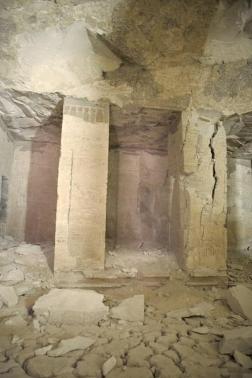
Geoscientist 17,1 January 2007
Fracture feature is the key to finding and protecting royal tombs, says Dwain Eldred
A 42-year-old method for finding water, monitoring pollution and helping with tunnelling may also be a way to locate and protect tombs in the Valleys of the Kings and Queens and other burial sites in Egypt.
The idea that fracture traces could bear some connection to the rock-cut tombs found in Egyptian valleys came to Katarin Parizek as she toured Egypt. Parizek, daughter of Richard Parizek, professor of geology and geo-environmental engineering at Penn State University, is a digital photographer, graphic designer and geologist. In 1992, on a Nile cruise to the Valley of the Kings near Luxor, she recognised the geological structures.
"Many of the tombs were in zones of fracture concentration revealed by fracture traces and lineaments" says Parizek, who teaches digital photography. "I knew that these fractures were what Dad used to find water or to plan dewatering projects."
Fracture traces at surface reveal the course of underlying zones of rock fracture. In 1964, Laurence Lattman and Richard Parizek published a paper on fracture traces that indicated where increased weathering and permeability occurred and hence where people could drill wells more easily, and with a greater chance of success. These fracture traces can be between 5 and 40 feet wide, but average about 20 feet, and can be as long as a mile depending on local ground conditions.
An initial study in Egypt showed that some tomb passages and resting chambers were aligned along these fracture zones, suggesting that the builders knew that these locations had less resistant rocks and made for easier digging. The Parizeks' work was reported today to the annual meeting of the Geological Society of America in Philadelphia.
More extensive surface and subsurface mapping confirmed the idea that the builders knew what they were doing. The tomb builders placed the entrances to their tombs in valley bottoms or receding depressions in the cliffs, where the crumbling stone would hide the tombs. These tombs, built between 1500 and 1000 BCE, usually have a long entry hall leading to a burial chamber. They may have additional rooms for equipment and provisions and other storage areas. Tomb walls are often plastered and painted. The tombs are usually built sloping downward or actually have vertical shafts. To date, 63 tombs are identified in the Valley of the Kings with tomb 63 located in February 2006.
"Katarin predicted that the location of still to be discovered tombs might be determined using the fracture-trace method" Parizek says. "The discovery of KV-63 showed the correlation between tombs and fracture traces."
While locating previously unidentified tombs is a worthy endeavour, perhaps even more important is preserving them. Many of these tombs are today open for viewing by the public and are the responsibility of the Egyptian Ministry of Antiquities. Maintaining the tombs is a complex and complicated job.
While it does not often rain in the desert, when it does, water pours off hills and runs over the land and into the wadis. Paving of parking lots, roads and paths to allow tomb visitors increases the flooding. Even though the Egyptians build barriers at the tomb entrances, water often flows into the tunnels causing irreversible damage to the tombs.
The open entrances, however, are not the only way water enters the tombs. Water finds the fracture concentrations beneath the fracture traces and seeps into the ground. If tombs are built along or below the traces, eventually water insinuates itself through the fractured rock and enters ruining the tomb in the process.
"If we can map the fracture traces and their associated fracture zones above and below ground, then we can see how to divert water so that it not only misses the tomb entrances, but also bypasses the permeable areas of the traces" says Richard Parizek.
Water entering tombs through the fractured rock also causes major damage to roofs and pillars. The researchers note that even without water, the pillars and roofs are more unstable on fracture zones. Because of these stability problems, many tombs are closed for fear of injury to visitors.